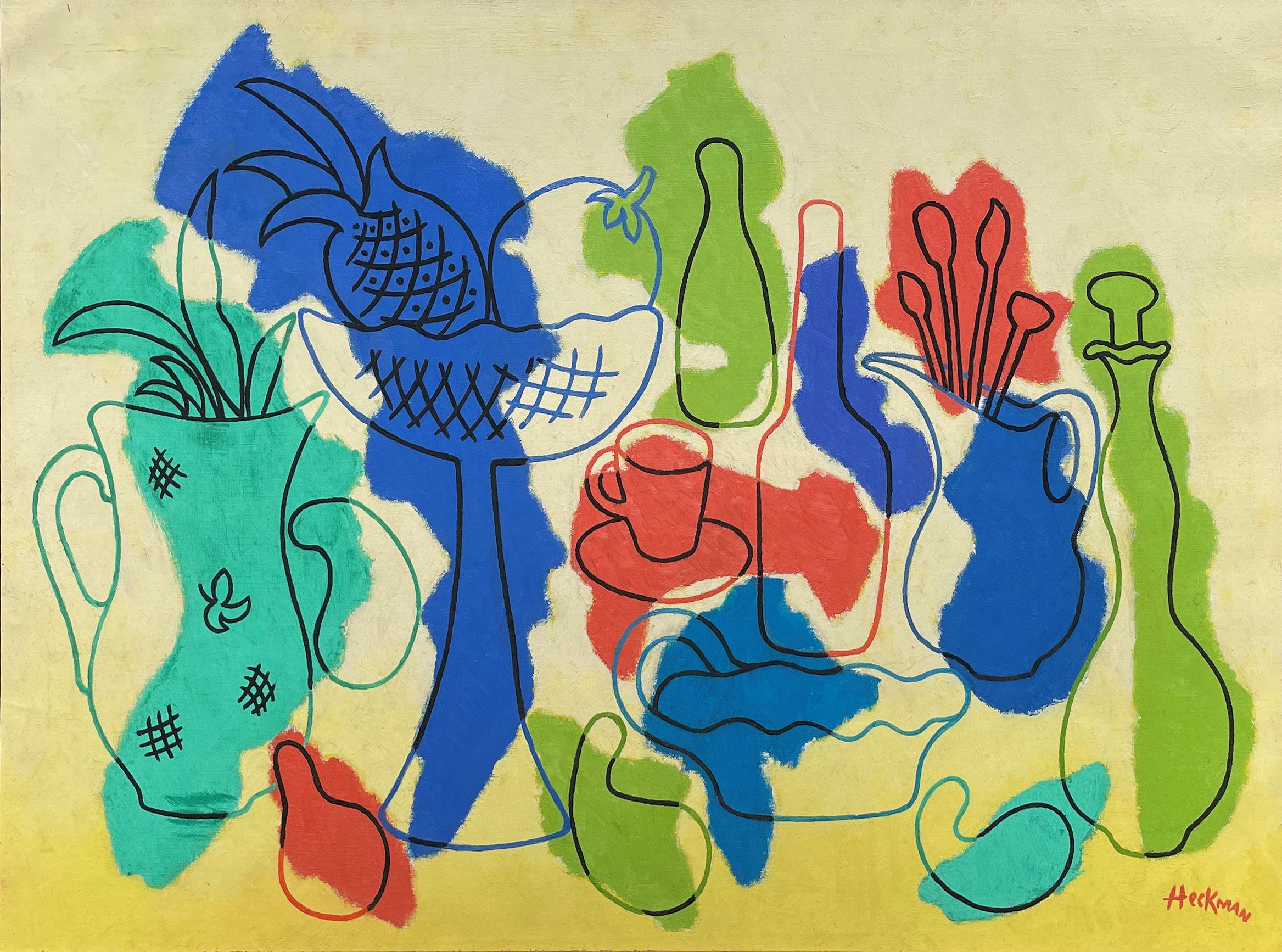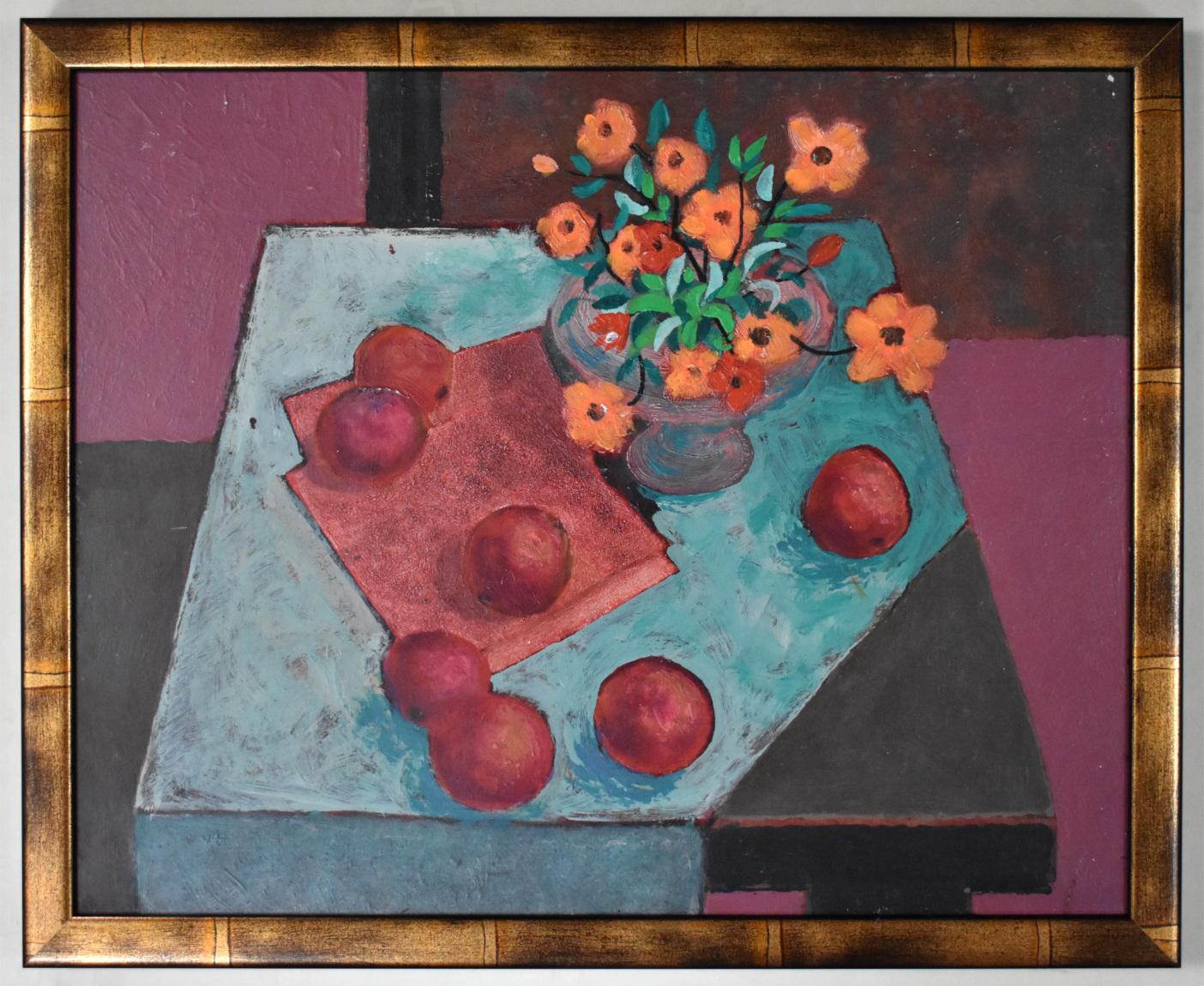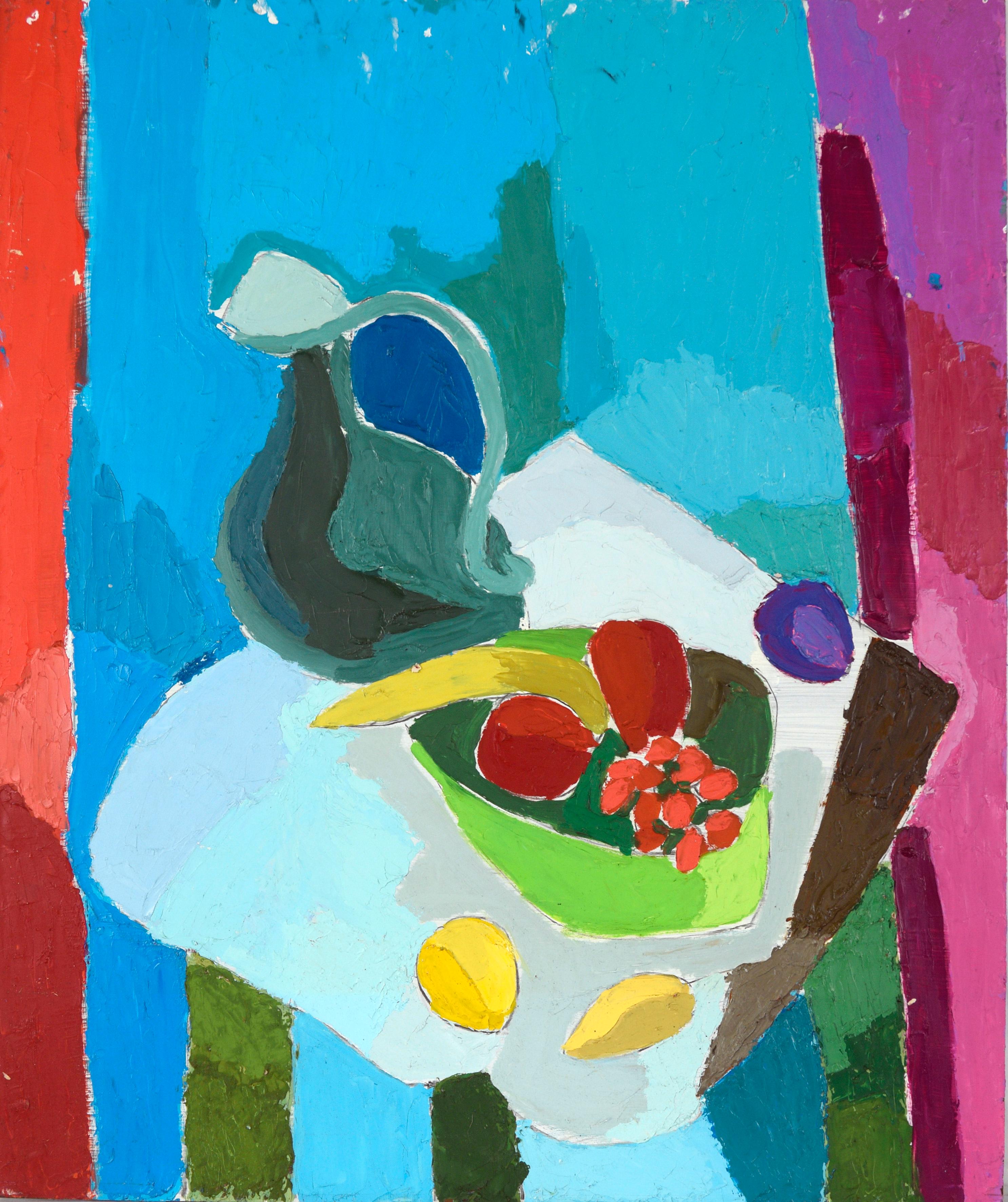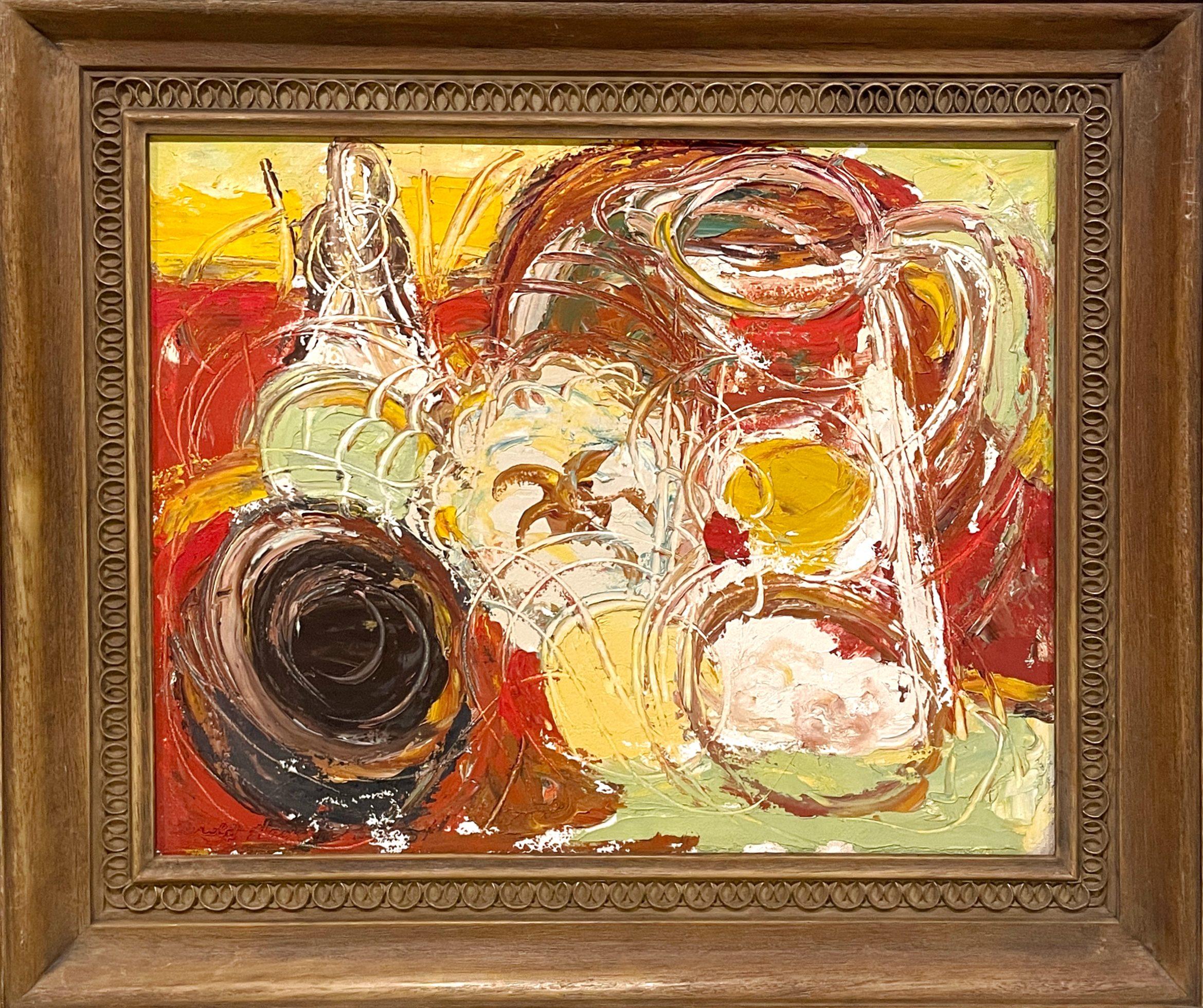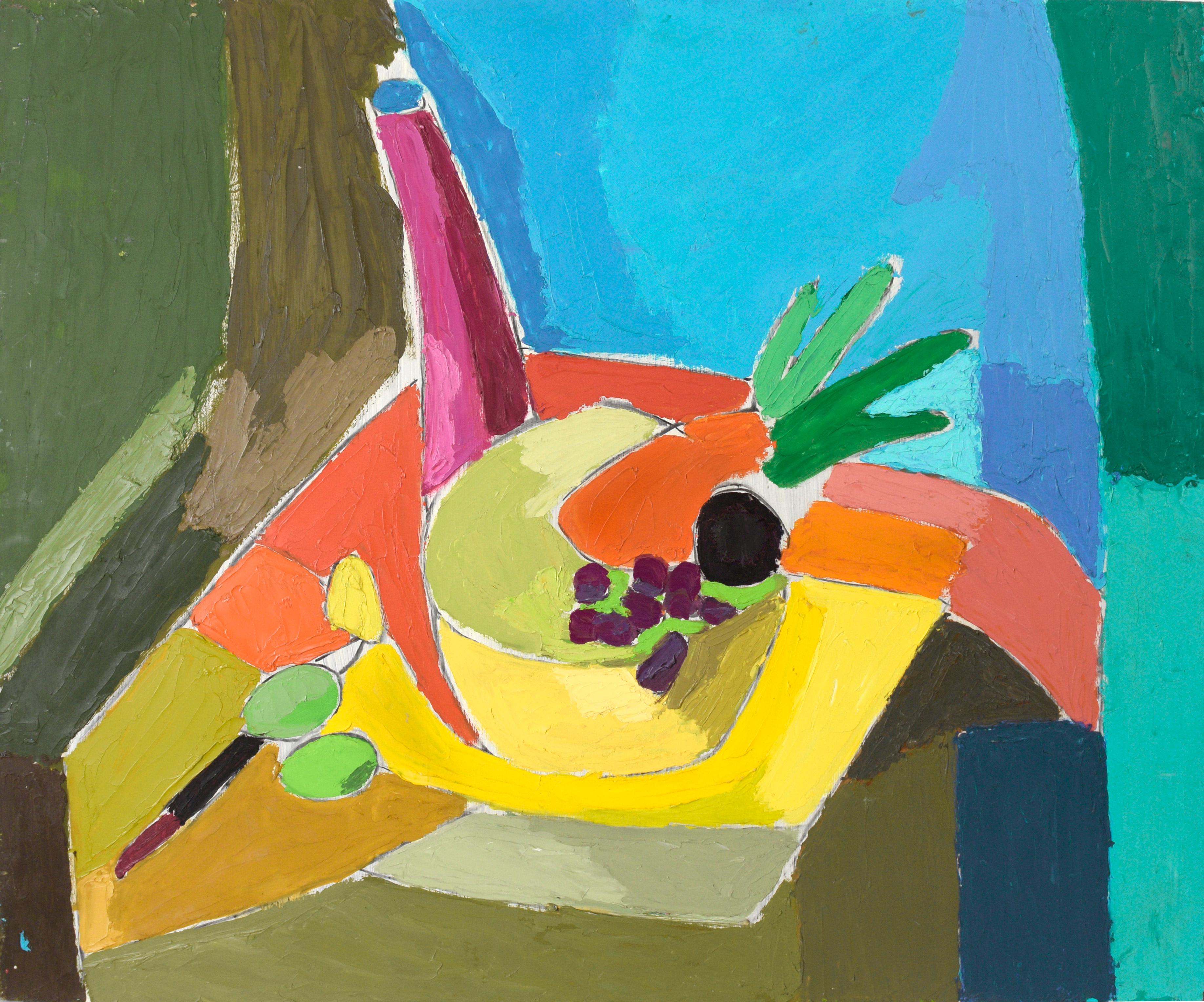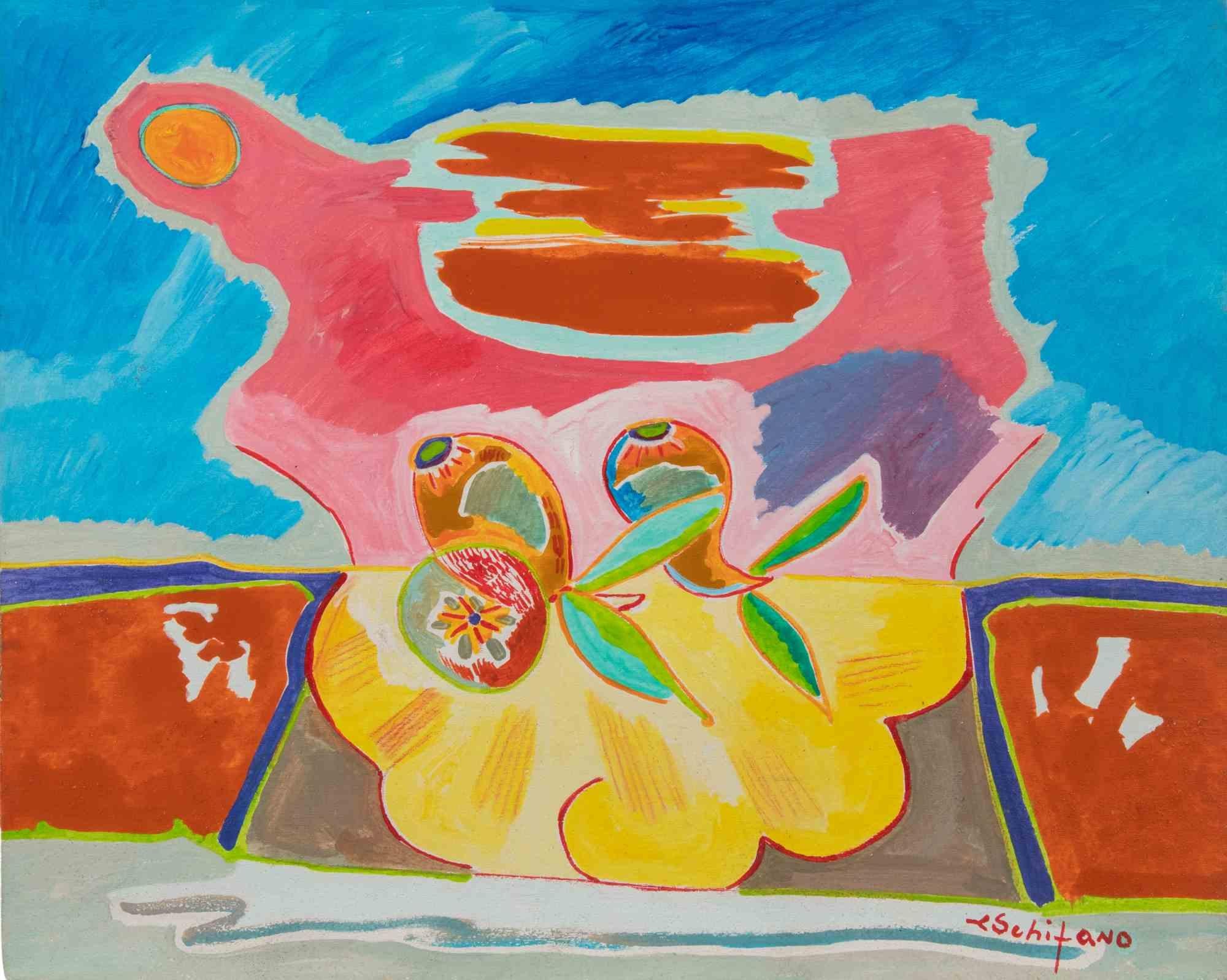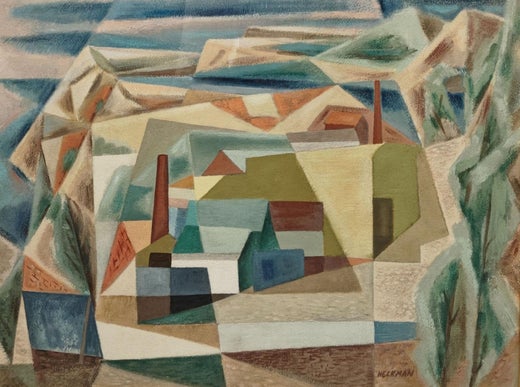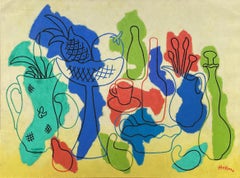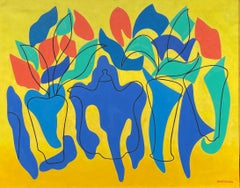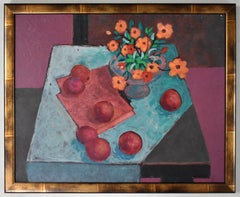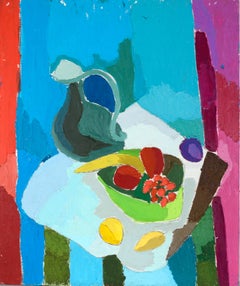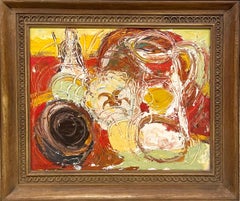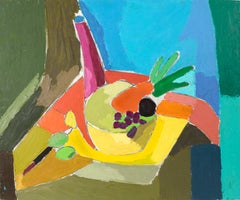Items Similar to "Untitled" Albert Heckman, circa 1950 Modernist Colorful Still Life With Fruit
Want more images or videos?
Request additional images or videos from the seller
1 of 5
Albert Heckman"Untitled" Albert Heckman, circa 1950 Modernist Colorful Still Life With Fruitcirca 1950
circa 1950
$8,000
£6,092.74
€7,013.56
CA$11,464.64
A$12,543.85
CHF 6,472.59
MX$150,211.30
NOK 82,172.64
SEK 76,987.84
DKK 52,376.76
About the Item
Albert Heckman
Untitled, circa 1950
Signed lower right
Oil on canvas
24 x 30 inches
Albert Heckman was born in Meadville, Western Pennsylvania, 1893. He went to New York City to try his hand at the art world in 1915 after graduating from high school and landing a job at the Meadville Post Office. In 1917, at the age of 24, Heckman enrolled part-time in Teachers' College, Columbia University's Fine Arts Department to begin his formal art education. He worked as a freelance ceramic and textile designer and occasionally as a lecturer at the Metropolitan Museum of Art. In the early 1920s, at the age of almost 30, he graduated with a Bachelor of Arts degree from Columbia Teachers College. He was especially impacted by his instructor at Columbia, Arthur Wesley Dow.
After graduating, he was hired by the Teachers' College as a Fine Arts instructor. He stayed with Columbia Teachers' College until 1929, when he left to attend the Leipzig Institute of Graphic Arts in Leipzig, Germany. Isami Doi (1903-1965), who was born in Hawaii, was arguably his most impressive student at Columbia. Doi is now regarded as one of the most prominent artists hailing from Hawaii. Heckman became an active member and officer of the Keramic Society and Design Guild of New York in the 1920s as part of his early commercial art career. The Society's mission was to share knowledge and showcase textile and ceramic design exhibits.
In 1922, Heckman married Florence Hardman, a concert violinist. Mrs. Heckman's concert schedule during the 1920s kept Albert and Florence Heckman apart for a significant portion of the time, but they spent what little time they had together designing and building their Woodstock, New York, summer house and grounds. A small house and an acre of surrounding land on Overlook Mountain, just behind the village of Woodstock, were purchased by Albert and Florence Heckman at the time of their marriage. Their Woodstock home, with its connections, friendships, and memories, became a central part of their lives over the years, even though they had an apartment in New York City.
Heckman's main artistic focus shifted to the house on Overlook Mountain and the nearby towns and villages, Kingston, Eddyville, and Glasco. After returning from the Leipzig Institute of Graphic Arts in 1930, Mr. Heckman joined Hunter College as an assistant professor of art. He worked there for almost thirty years, retiring in 1956. Throughout his tenure at Hunter, Mr. Heckman and his spouse spent the summers at their Woodstock residence and the winters in New York City. They were regular and well-known guests at the opera and art galleries in New York. Following his retirement in 1956, the Heckmans settled in Woodstock permanently, with occasional trips to Florida or Europe during the fall and winter. Mr. Heckman's close friends and artistic career were always connected to Woodstock or New York City. He joined the Woodstock art group early on and was greatly influenced by artists like Paul and Caroline Rohland, Emil Ganso, Yasuo Kuniyoshi, Andre Ruellan, and her husband, Jack Taylor.
Heckman operated a summer art school in Woodstock for several years in the 1930s with support from Columbia University, where these and other Woodstock artists gave guest lectures. The Potter's Shop in New York City hosted Mr. Heckman's first art show in December 1928. The exhibit received some positive reviews from critics. The American Institute of Graphic Arts chose the plate of "Wehlen, Saxony" as one of the "Fifty Prints of the Year in 1929." There were sixteen etchings displayed. The remaining plates depicted scenes in Saxony, Germany, while five of the plates were based on scenes in Rondout, New York.
Heckman started switching from etching to black and white lithography by the early 1930s. A lifelong admirer of Heckman's artwork, Mr. Gustave von Groschwitz organized a significant exhibition of Heckman etchings and lithographs at the Ferargil Gallery in New York City in 1933. The exhibition traveled to the Stendahl Galleries in Los Angeles (May 1933), the Charles Lessler Gallery in Philadelphia (May 1933), J.L. Hudson in Detroit (June 1933), and Gumps in San Francisco (July 1933). Together with his early etchings, the exhibition featured brand-new black and white lithographs depicting scenes in and around Woodstock as well as "A View from Tudor City," a black and white lithograph of a scene of 42nd Street in New York City. The exhibit was briefly mentioned in the New York Times and on April 23, 1933: "Mr. Heckman's work is strong and original as witness the "Rondout Bridge" etching which is scarcely more than an angle and reverse curves done with great sweep."
In 1935, von Groschwitz again arranged for a Heckman exhibition at the Ferargil Gallery. The exhibition consisted of black and white lithographs and pen and pencil drawings. The Herald Tribune wrote of these works, "His studies of trees drawn with lyrical feeling are notable." Despite modest sales and comparatively positive reviews from Times and Tribune critics, Mr. Heckrnan's formal one-man shows came to an end with the second exhibit at the Ferargil Gallery. He was to limit himself to showcasing individual pieces at both domestic and international exhibitions following his 1935 Ferargil Show.
Gertrude Vanderbilt Whitney was a significant influence on the Woodstock art scene in the early 1930s, first through her Greenwich Village Studio Club and then through the Whitney to promote American contemporary art. Mr. Heckman knew Herman More, the curator of the Whitney Museum, and Juliana Force, its first director, both of whom lived in Woodstock. From the First Biennial Exhibition of American Sculpture, Watercolor and Prints in December 1933 to the annual Exhibition of Sculpture, Watercolor and Drawings in 1956, Mr. Heckman displayed his work at Whitney exhibitions for nearly 25 years, in part because of these connections. Mr. Heckman' s major lithographs and prints made during the 1930s include the black and white lithographs "Bridge at Poughkeepsie," "Loading Lumber," “Oil
Yards at Rondout," "Car Barns at Kingston”, “Old Locks at Eddyville”, "Crossroads," "Stoney Hollow Railroad Station, "Rip Van Winkle Bridge," "Sudden Rain," and "Deserted Village”. In addition to his participation at the Whitney during the 1930's, Heckman presented lectures, using his work for illustrative purposes, at several colleges and universities on the object of etching and lithography. He actively participated in the Federal Art Projects during the 1930s Depression and created "Sudden Rain" and "Stoney Hollow Railway Station" as part of these initiatives. His black and white lithographs "Wind and Rain" and "Windblown Trees," as well as the roulette drypoint "Deserted Village," were featured in the first catalogues produced by the Associated American Artists, an organization of which Heckman was a founding member.
Heckman’s style had matured by the 1930s, transitioning from his early stiff etchings to more poetic black and white lithographs and drawings. He switched from etchings and black-and-white lithographs, which had been his primary mediums, to oils and watercolors in the late 1930s and early 1940s. Heckman's oil painting, "Eddyville, New York," was displayed in the Carnegie Institute's October–December 1941 Directions in American Painting exhibit in Pittsburgh. In 1942, his oil painting "Glasco Landscape" was displayed in the Metropolitan Museum of Art's Artists for Victory: An Exhibition of Contemporary American Art. Heckman finished a number of watercolor paintings of scenes in the Woodstock and Kingston, New York, areas in the 1940s.
In the 1950s, he painted a series of abstract watercolor designs that would serve as the foundation for a number of color lithographs. The Cincinnati Art Museum's Curator of Prints, Gustave von Groschwitz, began a series of international color lithography exhibitions in the 1950s. The color lithograph "Fruit Forms," which was displayed at the Whitney's Annual Exhibition of Contemporary American Sculpture, Watercolor and Prints in January 1937, is currently part of the Whitney permanent collection.
In 1958, Heckman retired from Hunter College, and the Heckmans relocated from New York City to Woodstock as their permanent residence. He mostly created abstract designs in oils, watercolors, and inks while he was retired. He didn't have many exhibitions in the 1960s. Appropriately, his final public display took place at an exhibition honoring the 50th anniversary of the Woodstock Artists Association in Woodstock, New York. The lithographer, painter, etcher, and teacher Albert Heckman cherished Woodstock and New York. With the intention of preserving the Woodstock art scene and way of life that he and his wife, Florence, had helped to create, he left money to the Woodstock Art Association in his will. He is buried in the Artists' Cemetery in Woodstock, New York, alongside his wife, Florence, after passing away in Kingston, New York, in February 1971.
- Creator:Albert Heckman (1893-1971, American)
- Creation Year:circa 1950
- Dimensions:Height: 31 in (78.74 cm)Diameter: 37 in (93.98 cm)
- More Editions & Sizes:Unique WorkPrice: $8,000
- Medium:
- Movement & Style:
- Period:
- Condition:
- Gallery Location:New York, NY
- Reference Number:1stDibs: LU1841215197262
Albert Heckman
Born in Meadville, Pennsylvania, Heckman came to NYC in 1915 and divided his time between there and Woodstock for the rest of his life except for 1929, when he studied in Leipzig. Married to concert violinist Florence Hardeman. Position: teacher, Hunter College, 1930-58; Teachers College Summer School, Woodstock, 1930s. Author: Paintings of Many Lands and Ages. He was a member of the Woodstock Art Association; and was also part of the Works Progress Administration Federal Arts Program in New York City, doing etching and block printing. He was influenced by Cubism and Expressionism.
About the Seller
5.0
Platinum Seller
Premium sellers with a 4.7+ rating and 24-hour response times
Established in 2022
1stDibs seller since 2022
126 sales on 1stDibs
Typical response time: <1 hour
- ShippingRetrieving quote...Shipping from: New York, NY
- Return Policy
Authenticity Guarantee
In the unlikely event there’s an issue with an item’s authenticity, contact us within 1 year for a full refund. DetailsMoney-Back Guarantee
If your item is not as described, is damaged in transit, or does not arrive, contact us within 7 days for a full refund. Details24-Hour Cancellation
You have a 24-hour grace period in which to reconsider your purchase, with no questions asked.Vetted Professional Sellers
Our world-class sellers must adhere to strict standards for service and quality, maintaining the integrity of our listings.Price-Match Guarantee
If you find that a seller listed the same item for a lower price elsewhere, we’ll match it.Trusted Global Delivery
Our best-in-class carrier network provides specialized shipping options worldwide, including custom delivery.More From This Seller
View All"Untitled" Albert Heckman, 1950s Modernist Abstracted Still Life Painting
By Albert Heckman
Located in New York, NY
Albert Heckman
Untitled, circa 1950
Signed lower right
Oil on canvas
21 1/4 x 29 inches
Albert Heckman was born in Meadville, Western Pennsylvania, 1893. He went to New York City to try his hand at the art world in 1915 after graduating from high school and landing a job at the Meadville Post Office. In 1917, at the age of 24, Heckman enrolled part-time in Teachers' College, Columbia University's Fine Arts Department to begin his formal art education. He worked as a freelance ceramic and textile designer and occasionally as a lecturer at the Metropolitan Museum of Art. In the early 1920s, at the age of almost 30, he graduated with a Bachelor of Arts degree from Columbia Teachers College. He was especially impacted by his instructor at Columbia, Arthur Wesley Dow.
After graduating, he was hired by the Teachers' College as a Fine Arts instructor. He stayed with Columbia Teachers' College until 1929, when he left to attend the Leipzig Institute of Graphic Arts in Leipzig, Germany. Isami Doi (1903-1965), who was born in Hawaii, was arguably his most impressive student at Columbia. Doi is now regarded as one of the most prominent artists hailing from Hawaii. Heckman became an active member and officer of the Keramic Society and Design Guild of New York in the 1920s as part of his early commercial art career. The Society's mission was to share knowledge and showcase textile and ceramic design exhibits.
In 1922, Heckman married Florence Hardman, a concert violinist. Mrs. Heckman's concert schedule during the 1920s kept Albert and Florence Heckman apart for a significant portion of the time, but they spent what little time they had together designing and building their Woodstock, New York, summer house and grounds. A small house and an acre of surrounding land on Overlook Mountain, just behind the village of Woodstock, were purchased by Albert and Florence Heckman at the time of their marriage. Their Woodstock home, with its connections, friendships, and memories, became a central part of their lives over the years, even though they had an apartment in New York City.
Heckman's main artistic focus shifted to the house on Overlook Mountain and the nearby towns and villages, Kingston, Eddyville, and Glasco. After returning from the Leipzig Institute of Graphic Arts in 1930, Mr. Heckman joined Hunter College as an assistant professor of art. He worked there for almost thirty years, retiring in 1956. Throughout his tenure at Hunter, Mr. Heckman and his spouse spent the summers at their Woodstock residence and the winters in New York City. They were regular and well-known guests at the opera and art galleries in New York. Following his retirement in 1956, the Heckmans settled in Woodstock permanently, with occasional trips to Florida or Europe during the fall and winter. Mr. Heckman's close friends and artistic career were always connected to Woodstock or New York City. He joined the Woodstock art group early on and was greatly influenced by artists like Paul and Caroline Rohland, Emil Ganso, Yasuo Kuniyoshi, Andre Ruellan, and her husband, Jack Taylor.
Heckman operated a summer art school in Woodstock for several years in the 1930s with support from Columbia University, where these and other Woodstock artists gave guest lectures. The Potter's Shop in New York City hosted Mr. Heckman's first art show in December 1928. The exhibit received some positive reviews from critics. The American Institute of Graphic Arts chose the plate of "Wehlen, Saxony" as one of the "Fifty Prints of the Year in 1929." There were sixteen etchings displayed. The remaining plates depicted scenes in Saxony, Germany, while five of the plates were based on scenes in Rondout, New York.
Heckman started switching from etching to black and white lithography by the early 1930s. A lifelong admirer of Heckman's artwork, Mr. Gustave von Groschwitz organized a significant exhibition of Heckman etchings and lithographs at the Ferargil Gallery in New York City in 1933. The exhibition traveled to the Stendahl Galleries in Los Angeles (May 1933), the Charles Lessler Gallery in Philadelphia (May 1933), J.L. Hudson in Detroit (June 1933), and Gumps in San Francisco (July 1933). Together with his early etchings, the exhibition featured brand-new black and white lithographs depicting scenes in and around Woodstock as well as "A View from Tudor City...
Category
1950s American Modern Figurative Paintings
Materials
Canvas, Oil
"Untitled" Albert Heckman, Modernist Saturated Blue and Yellow Still Life
By Albert Heckman
Located in New York, NY
Albert Heckman
Untitled, circa 1950
Signed lower right
Oil on canvas
18 x 24 inches
Albert Heckman was born in Meadville, Western Pennsylvania, 1893. He went to New York City to try his hand at the art world in 1915 after graduating from high school and landing a job at the Meadville Post Office. In 1917, at the age of 24, Heckman enrolled part-time in Teachers' College, Columbia University's Fine Arts Department to begin his formal art education. He worked as a freelance ceramic and textile designer and occasionally as a lecturer at the Metropolitan Museum of Art. In the early 1920s, at the age of almost 30, he graduated with a Bachelor of Arts degree from Columbia Teachers College. He was especially impacted by his instructor at Columbia, Arthur Wesley Dow.
After graduating, he was hired by the Teachers' College as a Fine Arts instructor. He stayed with Columbia Teachers' College until 1929, when he left to attend the Leipzig Institute of Graphic Arts in Leipzig, Germany. Isami Doi (1903-1965), who was born in Hawaii, was arguably his most impressive student at Columbia. Doi is now regarded as one of the most prominent artists hailing from Hawaii. Heckman became an active member and officer of the Keramic Society and Design Guild of New York in the 1920s as part of his early commercial art career. The Society's mission was to share knowledge and showcase textile and ceramic design exhibits.
In 1922, Heckman married Florence Hardman, a concert violinist. Mrs. Heckman's concert schedule during the 1920s kept Albert and Florence Heckman apart for a significant portion of the time, but they spent what little time they had together designing and building their Woodstock, New York, summer house and grounds. A small house and an acre of surrounding land on Overlook Mountain, just behind the village of Woodstock, were purchased by Albert and Florence Heckman at the time of their marriage. Their Woodstock home, with its connections, friendships, and memories, became a central part of their lives over the years, even though they had an apartment in New York City.
Heckman's main artistic focus shifted to the house on Overlook Mountain and the nearby towns and villages, Kingston, Eddyville, and Glasco. After returning from the Leipzig Institute of Graphic Arts in 1930, Mr. Heckman joined Hunter College as an assistant professor of art. He worked there for almost thirty years, retiring in 1956. Throughout his tenure at Hunter, Mr. Heckman and his spouse spent the summers at their Woodstock residence and the winters in New York City. They were regular and well-known guests at the opera and art galleries in New York. Following his retirement in 1956, the Heckmans settled in Woodstock permanently, with occasional trips to Florida or Europe during the fall and winter. Mr. Heckman's close friends and artistic career were always connected to Woodstock or New York City. He joined the Woodstock art group early on and was greatly influenced by artists like Paul and Caroline Rohland, Emil Ganso, Yasuo Kuniyoshi, Andre Ruellan, and her husband, Jack...
Category
1950s Modern Interior Paintings
Materials
Oil, Canvas
"Untitled" Albert Heckman, Still Life, Floral Abstracted Modernist Composition
By Albert Heckman
Located in New York, NY
Albert Heckman
Untitled, circa 1950
Signed lower right
Oil on canvas
25 1/4 x 32 1/4 inches
Albert Heckman was born in Meadville, Western Pennsylvania, 1893. He went to New York City to try his hand at the art world in 1915 after graduating from high school and landing a job at the Meadville Post Office. In 1917, at the age of 24, Heckman enrolled part-time in Teachers' College, Columbia University's Fine Arts Department to begin his formal art education. He worked as a freelance ceramic and textile designer and occasionally as a lecturer at the Metropolitan Museum of Art. In the early 1920s, at the age of almost 30, he graduated with a Bachelor of Arts degree from Columbia Teachers College. He was especially impacted by his instructor at Columbia, Arthur Wesley Dow.
After graduating, he was hired by the Teachers' College as a Fine Arts instructor. He stayed with Columbia Teachers' College until 1929, when he left to attend the Leipzig Institute of Graphic Arts in Leipzig, Germany. Isami Doi (1903-1965), who was born in Hawaii, was arguably his most impressive student at Columbia. Doi is now regarded as one of the most prominent artists hailing from Hawaii. Heckman became an active member and officer of the Keramic Society and Design Guild of New York in the 1920s as part of his early commercial art career. The Society's mission was to share knowledge and showcase textile and ceramic design exhibits.
In 1922, Heckman married Florence Hardman, a concert violinist. Mrs. Heckman's concert schedule during the 1920s kept Albert and Florence Heckman apart for a significant portion of the time, but they spent what little time they had together designing and building their Woodstock, New York, summer house and grounds. A small house and an acre of surrounding land on Overlook Mountain, just behind the village of Woodstock, were purchased by Albert and Florence Heckman at the time of their marriage. Their Woodstock home, with its connections, friendships, and memories, became a central part of their lives over the years, even though they had an apartment in New York City.
Heckman's main artistic focus shifted to the house on Overlook Mountain and the nearby towns and villages, Kingston, Eddyville, and Glasco. After returning from the Leipzig Institute of Graphic Arts in 1930, Mr. Heckman joined Hunter College as an assistant professor of art. He worked there for almost thirty years, retiring in 1956. Throughout his tenure at Hunter, Mr. Heckman and his spouse spent the summers at their Woodstock residence and the winters in New York City. They were regular and well-known guests at the opera and art galleries in New York. Following his retirement in 1956, the Heckmans settled in Woodstock permanently, with occasional trips to Florida or Europe during the fall and winter. Mr. Heckman's close friends and artistic career were always connected to Woodstock or New York City. He joined the Woodstock art group early on and was greatly influenced by artists like Paul and Caroline Rohland, Emil Ganso, Yasuo Kuniyoshi, Andre Ruellan, and her husband, Jack Taylor.
Heckman operated a summer art school in Woodstock for several years in the 1930s with support from Columbia University, where these and other Woodstock artists gave guest lectures. The Potter's Shop in New York City hosted Mr. Heckman's first art show in December 1928. The exhibit received some positive reviews from critics. The American Institute of Graphic Arts chose the plate of "Wehlen, Saxony" as one of the "Fifty Prints of the Year in 1929." There were sixteen etchings displayed. The remaining plates depicted scenes in Saxony, Germany, while five of the plates were based on scenes in Rondout, New York.
Heckman started switching from etching to black and white lithography by the early 1930s. A lifelong admirer of Heckman's artwork, Mr. Gustave von Groschwitz organized a significant exhibition of Heckman etchings and lithographs at the Ferargil Gallery in New York City in 1933. The exhibition traveled to the Stendahl Galleries in Los Angeles (May 1933), the Charles Lessler Gallery in Philadelphia (May 1933), J.L. Hudson in Detroit (June 1933), and Gumps in San Francisco (July 1933). Together with his early etchings, the exhibition featured brand-new black and white lithographs depicting scenes in and around Woodstock as well as "A View from Tudor City...
Category
1950s Abstract Figurative Paintings
Materials
Canvas, Oil
"Still Life of Fruit " Albert Swinden, American Abstract Association, AAA
By Albert Swinden
Located in New York, NY
Albert Swinden (1901 - 1961)
Still Life of Fruit, 1937
Oil on canvas
18 x 30 inches
Provenance:
Graham Gallery, New York
Albert Swinden (1901–1961) was an English-born American abstract painter. He was one of the founders of the American Abstract Artists, and he created significant murals as part of the Federal Art Project.
Albert Swinden was born in Birmingham, England in 1901. When he was seven, he moved with his family to Canada, and in 1919 he immigrated to the United States. He lived in Chicago, where he studied for about a year and a half at the Art Institute. He then relocated to New York City, where his art education continued briefly at the National Academy of Design. He soon changed schools again, to the Art Students League, which he attended from 1930 to 1934. He studied with Hans Hofmann and gained an appreciation for Synthetic Cubism and Neoplasticism. According to painter and printmaker George McNeil, Swinden "could have influenced Hofmann ... He was working with very, very simple planes, not in this sort of Cubistic manner. Swinden was working synthetically at this time." While still a student, Swinden began teaching at the Art Students League, in 1932.
Swinden married Rebecca Palter (1912–1998), from New York. Their daughter, Alice Swinden Carter, also became an artist. Carter, who attended the School of the Museum of Fine Arts, Boston, received an award from the Institute of Contemporary Art, Boston for her large sculptures.
Swinden was hired for the Federal Art Project (FAP) of the Works Progress Administration (WPA), and he is best known for the murals which he painted as part of that project.
In 1935, New York City Mayor Fiorello La Guardia attended the opening of the inaugural exhibit at the Federal Art Project Gallery, accompanied by Audrey McMahon, New York regional director for the Works Progress Administration/Federal Art Project. Among the works on display was Abstraction, a sketch by Swinden; it was the design for a mural planned for the College of the City of New York. A newspaper account described it as consisting of "brightly colored T-squares, triangles and rulers in horizontal, vertical and diagonal positions". La Guardia asked what it was, and upon being told it was a mural design, he said he didn't know what it depicted. Someone joked that it could be a map of Manhattan. The displeased mayor stated that "if that's art, I belong to Tammany Hall." (Tammany Hall, which the Republican mayor referenced, was the New York Democratic Party political society.) Fearing that the mayor's negative attitude could jeopardize the future of abstract art within the Federal Art Project, McMahon dispatched an assistant to summon an artist who could speak to the mayor in defense of abstraction. The assistant returned with Arshile Gorky.
Swinden played an important role in the founding of the American Abstract Artists. In 1935, he met with three friends, Rosalind Bengelsdorf, her future husband Byron Browne, and Ibram Lassaw, with the goal of exhibiting together. The group grew and started meeting in Swinden's studio, which adjoined those of Balcomb and Gertrude Greene...
Category
1930s Modern Still-life Paintings
Materials
Canvas, Oil
$4,800 Sale Price
20% Off
"An Orange Seducing a Lemon while a Bunch of Grapes Look On" Edward Zutrau, 1953
Located in New York, NY
Edward Zutrau
An Orange Seducing a Lemon while a Bunch of Grapes Look On, 4/20/1953
Signed, dated and titled on stretcher bar, and on the side of the work
Oil on linen
18 x 21 inches...
Category
1950s Abstract Expressionist Abstract Paintings
Materials
Canvas, Oil
"Untitled" Albert Heckman, Mid-Century American Modernist Abstract Composition
By Albert Heckman
Located in New York, NY
Albert Heckman
Untitled
Signed lower left
Oil on canvas
20 x 24 inches
Albert Heckman was born in Meadville, Western Pennsylvania, 1893. He went to New York City to try his hand at...
Category
1950s Modern Abstract Paintings
Materials
Canvas, Oil
You May Also Like
"STILL LIFE FRUIT" MID CENTURY
By Michael Frary
Located in San Antonio, TX
Michael Frary
(1918 - 2005)
Austin Artist
Image Size: 16 x 20
Frame Size: 17.5 x 21.5
Medium: Oil
"Still Life Fruit"
Biography
Michael Frary (1918 - ...
Category
1960s American Modern Still-life Paintings
Materials
Oil
Colorful Modernist Still Life with Fruit and Water Jug
Located in Soquel, CA
Colorful Modernist Still Life with Fruit and Water Jug by Ellis Hopkins (American, b. 1952).
This bold still life depicts a bowl of fruit resting on a table with a large green jug....
Category
Late 20th Century American Modern Still-life Paintings
Materials
Board, Oil
A Colorful, Expressionist 1950s Mid-Century Modern Still Life Painting
By Harold Haydon
Located in Chicago, IL
A Vibrant, Expressionist 1950s Mid-Century Modern Still Life Painting by Notable Chicago Artist, Harold Haydon (Am. 1909-1994). Depicting a bright and vivid studio still life scene ...
Category
Mid-20th Century Surrealist Still-life Paintings
Materials
Masonite, Oil
Color Block Modernist Still Life with Fruit Bowl
Located in Soquel, CA
Color Block Modernist Still Life with Fruit Bowl by Ellis Hopkins (American, b. 1952).
This bold still life depicts a yellow bowl of fruit sitting on a table next to a long bottle,...
Category
Late 20th Century American Modern Abstract Paintings
Materials
Oil, Board
Still Life with Fruits - Painting by Luciano Schifano - 1990s
Located in Roma, IT
Oil on board realized by Luciano Schifano (1943) in 1990s.
Hand signed and titled.
Good condition.
Category
1990s Contemporary Figurative Paintings
Materials
Oil
Expressionist Still Life with Plant and Fruit by Philadelphia Artist
By Bernard Harmon
Located in Doylestown, PA
"Red, Orange, Green with Plant" is a still life painting by Philadelphia born Expressionist painter Bernard Harmon from 1970. The 30.5" x 39" oil on board features a table top still ...
Category
1970s Expressionist Still-life Paintings
Materials
Oil, Board
More Ways To Browse
Vintage Gumps
Pittsburgh Paintings
Still Life With Oranges
Modern Art Fruit Painting
After The Rain Oil Paintings Street
Fruit Lithograph
Jack Taylor
Colorful Art Fruit
Tudor City
Rip Van Winkle
Isami Doi
Santiago Carbonell
Stupar Marko
Agapit Stevens Painting
Agapit Stevens
Alex Pauker
Anne Francoise Couloumy
Antique Oil Painting Flora
